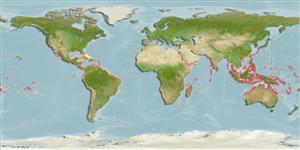Environment: milieu / climate zone / depth range / distribution range
Ecologia
marinhas associadas(os) a recifes; não migratória; intervalo de profundidade 1 - 5 m (Ref. 7247). Tropical; 30°N - 30°S
Indo-Pacific: Red Sea and East African coast to the Line and Society Islands, north to the Ryukyu and Bonin Islands, south to New Caledonia and Tonga; throughout Micronesia.
Tamanho / Peso / Idade
Maturity: Lm ? range ? - ? cm
Max length : 13.0 cm SL macho/indeterminado; (Ref. 7247)
Espinhos dorsais (total) : 12; Raios dorsais (total) : 14 - 16; Espinhos anais: 2; Raios anais : 12 - 14.
A territorial species commonly found in coral reef areas with dead staghorn corals. Adults feed on filamentous algae supported by these dead corals. Frequently charge human intruders without hesitation, sometimes taking painful nips which are mildly alarming when unexpected. Particularly aggressive during reproductive periods. They emit a clicking noise during aggressive encounters. Act aggressively toward most herbivorous fishes and some other fishes; defend its territory for feeding advantages (Ref. 47011). Oviparous, distinct pairing during breeding (Ref. 205). Eggs are demersal and adhere to the substrate (Ref. 205). Males guard and aerate the eggs (Ref. 205).
Ciclo de vida ou comportamento de acasalamento
Maturidade | Reprodução | Desova | Ovos | Fecundidade | Larvas
Oviparous, distinct pairing during breeding (Ref. 205). Eggs are demersal and adhere to the substrate (Ref. 205). Males guard and aerate the eggs (Ref. 205).
Allen, G.R. and A.R. Emery, 1985. A review of the Pomacentrid fishes of the genus Stegastes from the Indo-Pacific, with descriptions of two new species. Indo-Pac. Fish. (3):31. (Ref. 510)
Status na Lista Vermelha da UICN (Ref. 130435: Version 2024-2)
Uso pelos humanos
Pescarias: pouco comercial
Ferramentas
Relatórios especiais
Baixar XML
Fontes da internet
Estimates based on models
Preferred temperature (Ref.
123201): 25.5 - 29.3, mean 28.2 °C (based on 3835 cells).
Índice de diversidade filogenética (Ref.
82804): PD
50 = 0.5000 [Uniqueness, from 0.5 = low to 2.0 = high].
Bayesian length-weight: a=0.02344 (0.01401 - 0.03921), b=2.96 (2.82 - 3.10), in cm total length, based on LWR estimates for this species & Genus-body shape (Ref.
93245).
Nível Trófico (Ref.
69278): 2.0 ±0.0 se; based on diet studies.
Resiliência (Ref.
120179): Elevada, tempo mínimo de duplicação da população menor que 15 meses (Preliminary K or Fecundity.).
Fishing Vulnerability (Ref.
59153): Low vulnerability (10 of 100).
Nutrients (Ref.
124155): Calcium = 110 [53, 187] mg/100g; Iron = 0.749 [0.436, 1.329] mg/100g; Protein = 18 [17, 19] %; Omega3 = 0.0853 [, ] g/100g; Selenium = 17.6 [9.1, 37.6] μg/100g; VitaminA = 82.6 [19.0, 332.3] μg/100g; Zinc = 2.05 [1.33, 3.17] mg/100g (wet weight);
